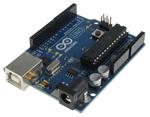...
The Arduino Uno is a microcontroller board based on the ATmega328 (datasheet). It has 14 digital
input/output pins (of which 6 can be used as PWM outputs), 6 analog inputs, a 16 MHz crystal oscillator, a
USB connection, a power jack, an ICSP header, and a reset button. It contains everything needed to support
the microcontroller; simply connect it to a computer with a USB cable or power it with a AC-to-DC adapter or
battery to get started.
The Uno differs from all preceding boards in that it does not use the FTDI USB-to-serial driver chip. Instead,
it features the Atmega8U2 programmed as a USB-to-serial converter.
"Uno" means "One" in Italian and is named to mark the upcoming release of Arduino 1.0. The Uno and
version 1.0 will be the reference versions of Arduino, moving forward. The Uno is the latest in a series of
USB Arduino boards, and the reference model for the Arduino platform; for a comparison with previous
versions, see the index of Arduino boards.
Techinal Specifications
Microcontroller
ATmega328
Operating Voltage
5V
Supply Voltage (recommended)
7-12V
Maximum supply voltage (not recommended) 20V
Digital I/O Pins
14 (of which 6 provide PWM output)
Analog Input Pins
6
DC Current per I/O Pin
40 mA
DC Current for 3.3V Pin
50 mA
Flash Memory
32 KB (ATmega328) of which 0.5 KB used by bootloader
SRAM
2 KB (ATmega328)
EEPROM
1 KB (ATmega328)
Clock Speed
16 MHz
If you want to give a closer look to this board we advice you to visit the official Arduino UNO page in the
Hardware Section.
1
�2
�
很抱歉,暂时无法提供与“A000046”相匹配的价格&库存,您可以联系我们找货
免费人工找货